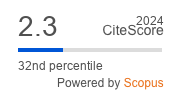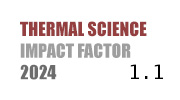THERMAL SCIENCE
International Scientific Journal
Thermal Science - Online First
online first only
Development of a reduced combustion mechanism for 2-butyltetrahydrofuran and its blends with diesel
ABSTRACT
2-Butyltetrahydrofuran is being investigated as a potential alternative fuel for diesel engines due to its self-ignition properties. This paper presents a reduced 2-butyltetrahydrofuran chemical kinetic mechanism for the first time, accompanied by an in-depth study of its combustion characteristics. N-heptane/toluene is a recognized surrogate mixture that effectively represents complex diesel for analyzing combustion behaviors. To achieve optimal combustion and application of 2-BTHF in diesel blends, this paper introduces a reliable mechanism for the 2-BTHF/n-heptane/toluene mixture for the first time. Firstly, directed relation graphs with error propagation, combined with isomer lumping and sensitivity analysis, are proposed to efficiently reduce detailed mechanisms, enhancing the approximation process in mechanism establishment. Results from the reduced 2-BTHF mechanism show that the cooperative methodology effectively diminishes the complexity of the detailed mechanism while improving its predictive capabilities. Secondly, the reduced 2-BTHF mechanism is combined and refined with those of n-heptane and toluene. Its accuracy is verified using diverse experimental data, including ignition delay times from shock tubes/rapid compressors and laminar flame speeds measured in combustion vessels. The final reduced chemical kinetic mechanism for the mixture comprises 78 species and 300 reactions, demonstrating significant potential for simulating the combustion behavior of 2-BTHF/n-heptane/toluene blends. Additionally, the study explores the impact of adding 2-BTHF to diesel fuel. Results reveal that increasing the proportion of blended 2-BTHF gradually raises the laminar flame speeds of diesel, while having minimal influence on ignition delay times.
KEYWORDS
PAPER SUBMITTED: 2025-02-16
PAPER REVISED: 2025-06-26
PAPER ACCEPTED: 2025-06-30
PUBLISHED ONLINE: 2025-08-02
- Zhu, J., et al., Autoignition behavior of methanol/diesel mixtures: Experiments and kinetic modeling, Combustion and Flame, 228 (2021), pp. 1-12
- Lin, Q., et al., Development of a compact and robust Polyoxymethylene Dimethyl Ether 3 reaction mechanism for internal combustion engines, Energy Conversion and Management, 185 (2019), pp. 35-43
- Mohan, B., et al., Experimental study of spray characteristics of biodiesel derived from waste cooking oil, Energy Conversion and Management, 88 (2014), pp. 622-632
- Wang, H., et al., Development of a reduced chemical kinetic mechanism for ammonia/diesel combustion over a wide range of ammonia energy ratios, Fuel, 381 (2025), p. 133536
- Ali Abuelnour, M., et al., Numerical investigation of hydrogen-diesel dual fuel engine: Combustion and emissions characteristics under varying hydrogen concentration and exhaust gas recirculation, Fuel, 377 (2024), p. 132794
- Lin, Q., et al., Auto-ignition of polyoxymethylene dimethyl ether 3 (PODE3) blended with diesel and gasoline via combustion under homogeneous charge compression ignition, Energy Conversion and Management: X, 11 (2021), p. 100093
- Li, S., et al., Development of a reduced n-heptane/toluene/tetrahydrofuran mechanism for dual-fuel engine combustion prediction, Fuel, 326 (2022), p. 124914
- Wang, H., et al., Development of an n-heptane-n-butanol-PAH mechanism and its application for combustion and soot prediction, Combustion and Flame, 160 (2013), 3, pp. 504-519
- Ulonska, K., et al., Screening pathways for the production of next generation biofuels, Energy & Fuels, 30 (2016), 1, pp. 445-456
- Wei, M., et al., Development and validation of a reduced MF/biodiesel mechanism for diesel engine application, Thermal Science, 27 (2023), 2 Part B, pp. 1465-1477
- Zhang, T., et al., Construction and validation of a reduced mechanism in a diesel engine fueled with 2-methylfuran-diesel, Thermal Science, 27 (2023), 2 Part B, pp. 1495-1505
- Sudholt, A., et al., Ignition characteristics of a bio-derived class of saturated and unsaturated furans for engine applications, Proceedings of the Combustion Institute, 35 (2015), 3, pp. 2957-2965
- Chen, K., et al. Development of n-heptane/2-butyltetrahydrofuran mechanism based on decoupling approach,Journal of Physics: Conference Series,2024,2683, p. 012008
- Cai, L., et al., Experimental and numerical study of a novel biofuel: 2-Butyltetrahydrofuran, Combustion and Flame, 178 (2017), pp. 257-267
- Xu, N., et al., Review on the production methods and fundamental combustion characteristics of furan derivatives, Renewable and Sustainable Energy Reviews, 54 (2016), pp. 1189-1211
- Guan, C., et al., Effects of oxygenated fuels on the particle-phase compounds emitted from a diesel engine, Atmospheric Pollution Research, 8 (2017), 2, pp. 209-220
- Rudolph, T., Thomas J., NOx, NMHC and CO emissions from biomass derived gasoline extenders, Biomass, 16 (1988), 1, pp. 33-49
- Wu, S., et al., Development of a highly compact and robust chemical reaction mechanism for the oxidation of tetrahydrofurans under engine relevant conditions, Fuel, 276 (2020), p. 118034
- Jerzembeck, S., et al., Laminar burning velocities at high pressure for primary reference fuels and gasoline: Experimental and numerical investigation, Combustion and Flame, 156 (2009), 2, pp. 292-301
- Kumar, K., et al., Laminar flame speeds of preheated iso-octane/O2/N2 and n-heptane/O2/N2 mixtures, Journal of propulsion and power, 23 (2007), 2, pp. 428-436
- Hartmann, M., et al., Auto-ignition of toluene-doped n-heptane and iso-octane/air mixtures: High-pressure shock-tube experiments and kinetics modeling, Combustion and Flame, 158 (2011), 1, pp. 172-178
- Luo, J., et al., Experimental and numerical study on suitable diesel fuel surrogates in low temperature combustion conditions, Fuel, 97 (2012), pp. 621-629
- Ciezki, H.K., Adomeit G., Shock-tube investigation of self-ignition of n-heptane-air mixtures under engine relevant conditions, Combustion and Flame, 93 (1993), 4, pp. 421-433
- Sileghem, L., et al., Laminar burning velocity of gasoline and the gasoline surrogate components iso-octane, n-heptane and toluene, Fuel, 112 (2013), pp. 355-365
- Hui, X., Sung C.-J., Laminar flame speeds of transportation-relevant hydrocarbons and jet fuels at elevated temperatures and pressures, Fuel, 109 (2013), pp. 191-200
- Chong, C.T., Hochgreb s., Measurements of laminar flame speeds of liquid fuels: Jet-A1, diesel, palm methyl esters and blends using particle imaging velocimetry (PIV), Proceedings of the Combustion Institute, 33 (2011), 1, pp. 979-986
- Herzler, J., et al., Shock-tube study of the autoignition of n-heptane/toluene/air mixtures at intermediate temperatures and high pressures, Combustion and Flame, 149 (2007), 1, pp. 25-31
- Turanyi, T., et al., Reaction rate analysis of complex kinetic systems, International Journal of Chemical Kinetics, 21 (1989), 2, pp. 83-99
- Pepiot-Desjardins, P., Pitsch H., An efficient error-propagation-based reduction method for large chemical kinetic mechanisms, Combustion and Flame, 154 (2008), 1-2, pp. 67-81
- Pepiot-Desjardins, P., Pitsch H., An automatic chemical lumping method for the reduction of large chemical kinetic mechanisms, Combustion Theory and Modelling, 12 (2008), 6, pp. 1089-1108
- DESIGNS, M.E., Chemkin-pro, Ansys. (2011)
- Laidler, K.J., The development of the Arrhenius equation, Journal of chemical Education, 61. (1984), 6, p. 494
- Glassman, I., et al., Combustion. Academic press, 2014
- Li, S., et al., Development of a phenomenological soot model integrated with a reduced TRF-PAH mechanism for diesel engine application, Fuel, 283 (2021), p. 118810
- Chang, Y., et al., Development of a skeletal mechanism for diesel surrogate fuel by using a decoupling methodology, Combustion and Flame, 162 (2015), 10, pp. 3785-3802
- Heng, Y., et al., High-pressure ignition behaviors of methane/ethane/propane-n-heptane mixtures representing natural gas-diesel dual fuel, Thermal Science, 28 (2024), 1 Part A, pp. 115-132

